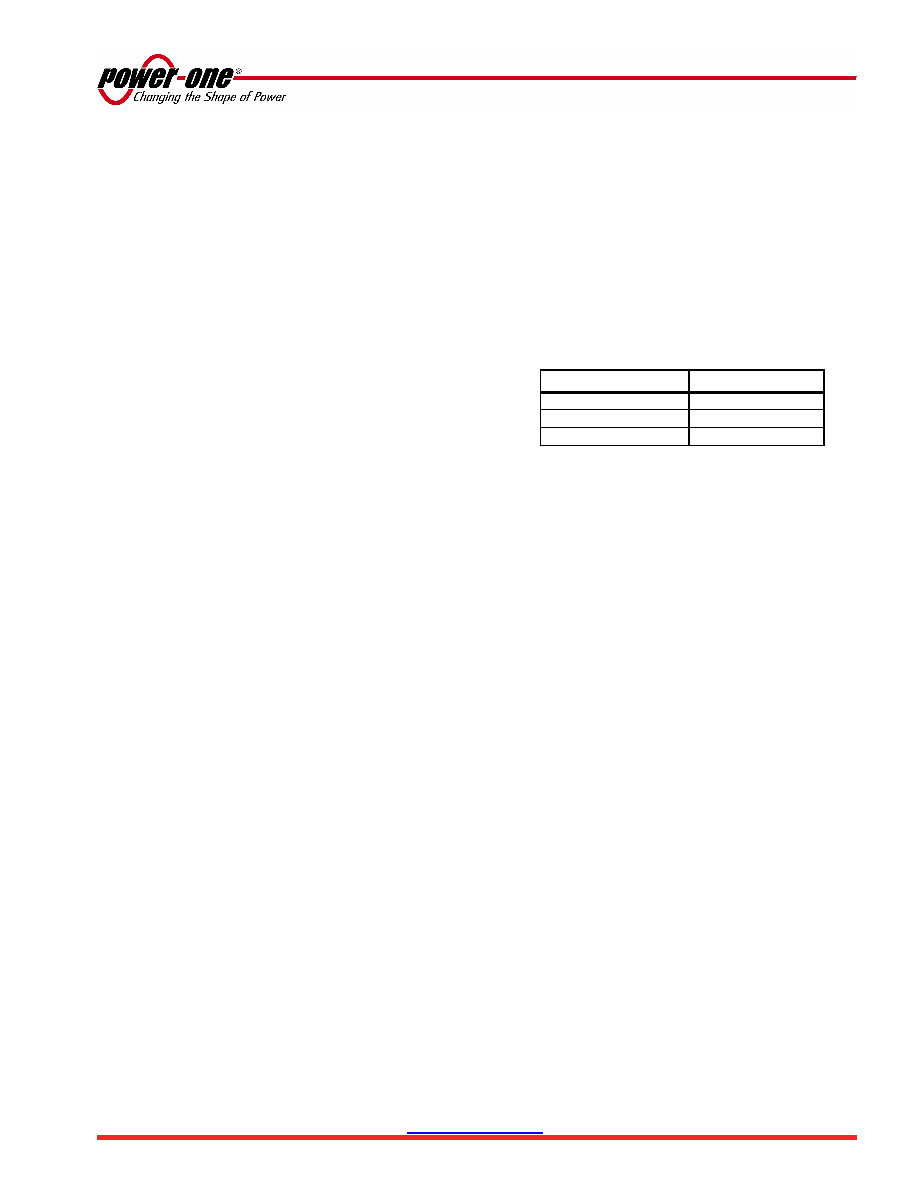- 您現(xiàn)在的位置:買賣IC網(wǎng) > PDF目錄224955 > QME48T40018-NGA0G (POWER-ONE INC) 1-OUTPUT DC-DC REG PWR SUPPLY MODULE PDF資料下載
參數(shù)資料
| 型號: | QME48T40018-NGA0G |
| 廠商: | POWER-ONE INC |
| 元件分類: | 電源模塊 |
| 英文描述: | 1-OUTPUT DC-DC REG PWR SUPPLY MODULE |
| 封裝: | ROHS COMPLIANT |
| 文件頁數(shù): | 33/35頁 |
| 文件大小: | 1435K |
| 代理商: | QME48T40018-NGA0G |
第1頁第2頁第3頁第4頁第5頁第6頁第7頁第8頁第9頁第10頁第11頁第12頁第13頁第14頁第15頁第16頁第17頁第18頁第19頁第20頁第21頁第22頁第23頁第24頁第25頁第26頁第27頁第28頁第29頁第30頁第31頁第32頁當前第33頁第34頁第35頁

QME48T40 DC-DC Series Data Sheet
36-75 VDC Input; 1.0-3.3 VDC @ 40A Output
Protection Features
Input Undervoltage Lockout
Input undervoltage lockout is standard with this
converter. The converter will shut down when the
input voltage drops below a pre-determined voltage.
The input voltage must be typically 34 V for the
converter to turn on. Once the converter has been
turned on, it will shut off when the input voltage
drops typically below 32 V. This feature is beneficial
in preventing deep discharging of batteries used in
telecom applications.
Output Overcurrent Protection (OCP)
The converter is protected against overcurrent or
short circuit conditions. Upon sensing an overcurrent
condition, the converter will switch to constant
current operation and thereby begin to reduce output
voltage. When the output voltage drops below 60%
of the nominal value of output voltage, the converter
will shut down.
Once the converter has shut down, it will attempt to
restart nominally every 200 ms with a typical 3-5%
duty cycle. The attempted restart will continue
indefinitely until the overload or short circuit
conditions are removed or the output voltage rises
above 40-50% of its nominal value.
Once the output current is brought back into its
specified range, the converter automatically exits the
hiccup mode and continues normal operation.
Output Overvoltage Protection (OVP)
The converter will shut down if the output voltage
across Vout(+) (Pin 8) and Vout(-) (Pin 4) exceeds
the threshold of the OVP circuitry. The OVP circuitry
contains its own reference, independent of the output
voltage regulation loop. Once the converter has shut
down, it will attempt to restart every 200 ms until the
OVP condition is removed.
Overtemperature Protection (OTP)
The
converter
will
shut
down
under
an
overtemperature condition to protect itself from
overheating caused by operation outside the thermal
derating curves, or operation in abnormal conditions
such as system fan failure. After the converter has
cooled to a safe operating temperature, it will
automatically restart.
Safety Requirements
The
converters
meet
North
American
and
International safety regulatory requirements per
UL60950 and EN60950 (pending). Basic Insulation is
provided between input and output.
To comply with safety agencies’ requirements, an
input line fuse must be used external to the
converter.
The
Table
below
provides
the
recommended fuse rating for use with this family of
products.
Output Voltage
Fuse Rating
3.3 V
7.5 A
2.5 V, 1.8 V
5 A
1.5 V, 1.2 V, 1.0 V
3 A
All QME converters are UL approved (pending) for a
maximum fuse rating of 15 Amps. To protect a group
of converters with a single fuse, the rating can be
increased from the recommended value above.
Electromagnetic Compatibility (EMC)
EMC requirements must be met at the end-product
system level, as no specific standards dedicated to
EMC characteristics of board mounted component
dc-dc converters exist. However, Power-One tests its
converters to several system level standards,
primary of which is the more stringent EN55022,
Information
technology
equipment
-
Radio
disturbance characteristics-Limits and methods of
measurement.
An effective internal LC differential filter significantly
reduces input reflected ripple current, and improves
EMC.
With the addition of a simple external filter, all
versions of the QME-Series of converters pass the
requirements of Class B conducted emissions per
EN55022 and FCC requirements. Please contact
Power-One Applications Engineering for details of
this testing.
ZD-02057 Rev. 4.1
www.power-one.com
Page 7 of 35
相關PDF資料 |
PDF描述 |
|---|---|
| QMS-016-11-H-D-DP-A-GP | 32 CONTACT(S), MALE, STRAIGHT TWO PART BOARD CONNECTOR, SURFACE MOUNT |
| QMS-016-11-L-D-DP-A-GP | 32 CONTACT(S), MALE, STRAIGHT TWO PART BOARD CONNECTOR, SURFACE MOUNT |
| QMS-032-10-H-D-DP-A-GP | 64 CONTACT(S), MALE, STRAIGHT TWO PART BOARD CONNECTOR, SURFACE MOUNT |
| QMS-032-10-L-D-DP-A-GP | 64 CONTACT(S), MALE, STRAIGHT TWO PART BOARD CONNECTOR, SURFACE MOUNT |
| QMS-032-10-L-D-DP-A-RT1 | 66 CONTACT(S), MALE, STRAIGHT TWO PART BOARD CONNECTOR, SURFACE MOUNT |
相關代理商/技術參數(shù) |
參數(shù)描述 |
|---|---|
| QME48T40018-NGB0 | 功能描述:DC/DC轉換器 RoHS:否 制造商:Murata 產(chǎn)品: 輸出功率: 輸入電壓范圍:3.6 V to 5.5 V 輸入電壓(標稱): 輸出端數(shù)量:1 輸出電壓(通道 1):3.3 V 輸出電流(通道 1):600 mA 輸出電壓(通道 2): 輸出電流(通道 2): 安裝風格:SMD/SMT 封裝 / 箱體尺寸: |
| QME48T40018-NGB0G | 功能描述:DC/DC轉換器 RoHS:否 制造商:Murata 產(chǎn)品: 輸出功率: 輸入電壓范圍:3.6 V to 5.5 V 輸入電壓(標稱): 輸出端數(shù)量:1 輸出電壓(通道 1):3.3 V 輸出電流(通道 1):600 mA 輸出電壓(通道 2): 輸出電流(通道 2): 安裝風格:SMD/SMT 封裝 / 箱體尺寸: |
| QME48T40018-NGBOG | 制造商:POWER-ONE INC 功能描述:PwrSup;DC-DC Converter;Out 1.8VDC;In 36 to 75VDC;Thru-Hole;Open-Frame;Switching |
| QME48T40018-PGB0 | 制造商:Power-One 功能描述:DC/DC PS SGL-OUT 1.8V 40A 8PIN QUARTER-BRICK - Bulk |
| QME48T40018-PGB0G | 功能描述:DC/DC轉換器 36-75Vin 40A 18V out Positive, Thru Hole RoHS:否 制造商:Murata 產(chǎn)品: 輸出功率: 輸入電壓范圍:3.6 V to 5.5 V 輸入電壓(標稱): 輸出端數(shù)量:1 輸出電壓(通道 1):3.3 V 輸出電流(通道 1):600 mA 輸出電壓(通道 2): 輸出電流(通道 2): 安裝風格:SMD/SMT 封裝 / 箱體尺寸: |
發(fā)布緊急采購,3分鐘左右您將得到回復。